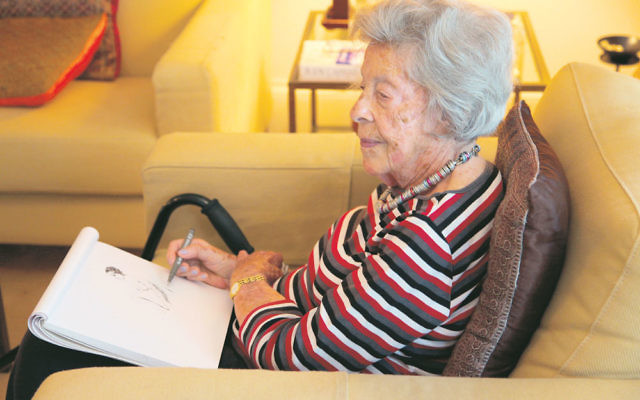Honouring Judy Cassab
Archibald Prize-winning artist Judy Cassab, who died earlier this month in Sydney aged 95, was loved by her family, friends and members of the art world for her lifetime of painting.
TWO years ago a major exhibition by Archibald Prize-winning artist Judy Cassab, aptly named Judy Cassab, A Celebration, was held at Eva Breuer Art Dealer in Sydney, and a few months later at Melbourne’s Mossgreen Gallery.
It was the brainchild of Cassab’s son, John Seed, to celebrate the 60th anniversary of her first exhibition at Macquarie Galleries in Sydney in 1953, and featured more than 100 paintings.
At the time Seed said: “These kind of exhibitions are usually held after someone dies, but I thought it would be great if she could enjoy the celebrations while she is alive.”
It was her last major exhibition – the 95-year-old artist died on November 3 after spending her final years in the Montefiore nursing home in Randwick.
In the days after Cassab’s funeral at Temple Emanuel in Woollahra, attended by more than 250 mourners, Seed reflected on that exhibition.
“I was very happy that we did the exhibition,” he told The AJN. “It gave her a lot of pleasure.”
Tributes have poured in for Cassab from members of the art world, famous people who sat for her paintings and community leaders.
“It’s hard to find a Jewish house in (Sydney’s) eastern suburbs without a portrait by her,” says Seed.
On the evening of the funeral there was a gathering of family and friends at the home of Cassab’s other son, Peter Kampfner, and during the evening a large box of fruit was delivered to the house.
Seed said: “Someone checked the card to see who it was from and it read, Malcolm and Lucy Turnbull. They were offering their regrets that they could not attend the funeral.”
Former High Court judge Michael Kirby, who has had his portrait painted by Cassab and became a close friend, was also unable to attend the funeral and sent his condolences.
“Unfortunately I will be in Seoul, Korea, in connection with my duties for the United Nations on North Korea,” he wrote in an email to Seed.
“As Judy survived other, earlier tyrants, I think she would expect me to remain at my post on this occasion. But I will be thinking of you, Peter and your family – above all of Judy – all that day.”
Born Judit Kaszab in 1920 in Vienna to Hungarian parents, Cassab was raised by her mother and grandmother in Beregszász, Hungary. Between 1939 and 1949, Cassab studied art in Prague and at the Budapest Academy, but her studies were interrupted by the Nazi occupation. She survived the war using forged identity papers supplied by her maid.
Cassab’s husband Jansci Kampfner was a survivor of the forced labour camps. They migrated to Australia in 1951 with their two young sons, Janos (who later change his name to John Seed) and Peter.
In Sydney Cassab quickly gained recognition for her landscape and portrait art. She won the prestigious Archibald Prize for portraiture in 1961 and 1968.
Over the years she held more than 70 solo exhibitions throughout Australia, as well as in London and Paris.
In 1969 she was made a Commander of the Order of the British Empire (CBE) in recognition of service to the visual arts, followed by being named an Officer of the Order of Australia (AO) in 1988.
Cassab demonstrated her artistic talent at an early age – her mother bought her a set of crayons for her 12th birthday and she drew a drawing of her grandmother. The artwork looked as if it had been painted by an artist with years of experience. The drawing has been hanging in her room at Montefiore in recent years.
Cassab loved to paint, and until recently painted every day. And since the age of 12 she kept a diary about her life.
Seed, an environmental campaigner and sculptor, said: “I moved back to Sydney in 2008 after an absence of 40 years, so as to be closer to Judy in her decline. Almost daily I read from her diary to her. When we finished the 2000 typewritten pages we started from the beginning again!”
A copy of the diary is held in the National Library of Australia in Canberra and excerpts were published in 1995 in a book, Judy Cassab’s Diaries.
In his eulogy at the funeral, Seed said: “What I would like to celebrate now is the goodness which was so central to her character, to her very being. A goodness that radiated from her and that was palpable. No-one could fail to notice it.
“There was not a mean bone in her body and she was the only one I have ever known for whom everyone who knew her felt at least affection and friendliness. This goodness was mysterious, spontaneous and innocent. It was unconstructed, uncontrived, unstudied, innate, never absent.”
Seed added: “It is quite inspiring that someone can suffer so much and be such a loving person. She died with a smile.
“She was a refugee washed ashore after the murder of most of her family and community. How fortunate for all concerned that this country, in its own young innocence and goodness, welcomed her aboard.”
REPORT by Danny Gocs


comments